Unsure about your French table manners? Click Here to download > > How to avoid these 10 food etiquette mistakes !
- Home ›
- Destinations ›
- Normandy ›
- Caen
Things To Do In Caen, Normandy's Most Norman City
Published 11 November 2025 by Leyla Alyanak — Parisian by birth, Lyonnaise by adoption, historian by passion
Looking for things to do in Caen? Visit William the Conqueror’s castle and abbeys, explore WWII history, enjoy local markets, and discover the city’s Norman character, all covered in the article below.
Most people either drive straight through Caen on their way to Bayeux or the D-Day beaches, or use its train station, without visiting the city. I know because I was guilty of this twice before I actually visited Caen.
(How to pronounce it? CON - but stop just before the N!)
IF YOU VISIT CAEN
- Don't miss: the Caen Mémorial, the two abbeys, the coast and D-Day beaches
- Here's where you can book your train tickets.
- For stays, in the heart of the action, booking.com has flexible cancellation policies.
- If you're renting a car to head for the coast, compare prices on Discovercars.
- If you'd rather take a tour, check out these short tours in and around Caen.
I hadn't realized there were so many fascinating things to do here – until I gave it a chance.
If you love history, this is a city you won't want to miss. It's called the most Norman city in Normandy for a reason: from being William the Conqueror's capital to the heavy damage it sustained during the Battle of Normandy to the rebuilding efforts that have turned it into a symbol of postwar recovery, this is a city that traces time across the centuries.
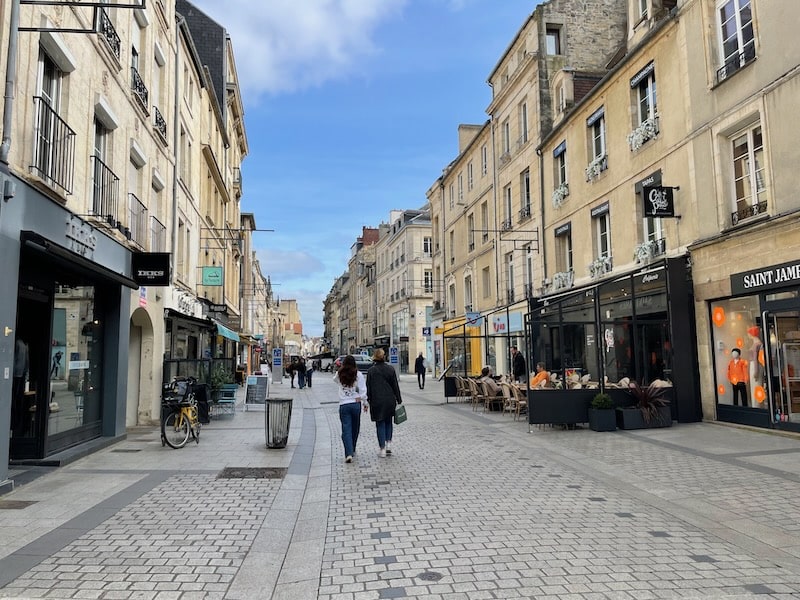
A brief history of Caen
Alongside Rouen, Normandy's capital, William the Conqueror developed the city of Caen in the 11th century as his personal power base, leaving behind ample evidence of his presence: he build Caen Castle and two impressive abbeys, turning this modest town into a ducal dominion.
Rouen remained the official capital of Normandy, but Caen became William's political and personal seat of government.
Caen was a strategic choice, sitting as it does between Rouen and the English Channel, which made it relatively easy to defend (both from the outside and from rebellious local barons) but close enough to the maritime routes.
Caen would remain an intellectual center and over the centuries would gain in stature until it became the capital of Lower Normandy, with Rouen the capital of Upper Normandy.
World War II intervened and the city William had so painstakingly built was severely damaged when it was bombed by the Allies' effort to push out the Nazi regime.
CAEN DURING WORLD WAR II
When the Allies landed in Normandy, Caen was under German control, so it became a priority for Allied forces. To capture Caen, however, it had to be nearly destroyed, and casualties and damage were extensives as civilians were caught between the two powerful forces:
- heaving bombing raids by British and Canadian forces and by Germans resisting them sent locals scurrying into crypts and churches for protection
- the heavy raids destroyed or damaged 75% of the city, including its medieval historic center
- more than 2000 civilians were killed
 Canadian soldiers walking through the devastated streets of Caen (Canadian National Archives)
Canadian soldiers walking through the devastated streets of Caen (Canadian National Archives)Shelling continued from early June until liberation on 9 July, and while residents accepted the need for military action, the human cost was acute. After liberation many expressed their gratitude, but it was a bittersweet victory, filled with sorrow at so much loss.
Caen was not pleased when in 2016 (the year France's regions were reorganized) Rouen became Normandy's official capital. Still, Caen retained plenty of regional institutions, and while annoyed, it seems to have accepted its new status with relative grace, becoming the intellectual and innovation center of Normandy while Rouen remains its historical center.
Today, pockets of Caen retain their medieval charm, but the city has been largely rebuilt – and not too badly, at that!
 Modern Caen as seen from the steps of the Mémorial de Caen ©OffbeatFrance
Modern Caen as seen from the steps of the Mémorial de Caen ©OffbeatFranceThings to do in Caen
Caen is a city for lovers of history, whether medieval or contemporary. For long the beating heart of Normandy, the city reminds us that even a thousand years isn't enough to forget the past.
Château de Caen
This is an imposing fortress, in fact one of Europe's largest, built around 1060 by William the Conqueror.
Like many, it served multiple purposes: it was a ducal residence, a chapel, and of course military quarters.
Stroll around the ramparts for a broad view of the city, or just to imagine scenes from a millennium ago.
 The ramparts of Caen Castle
The ramparts of Caen CastleWilliam once held court in the ducal palace and managed his Norman territories from here before his famous voyage to England. Only its foundations remain, but their size hints at how significant Caen was to his rule. The Église Saint-Georges, his private chapel, still survives and marks the spiritual heart of the fortress.
Over the centuries, the castle was expanded, first by William’s successors, then by the French kings after Normandy’s annexation, and again during later wars.
Until World War II, when it was occupied by German troops and suffered damage during the 1944 bombardments.
Today, it is more than a castle, housing not one but two museums.
The first, the Musée des Beaux-Arts (Fine Arts) displays works as diverse as Poussin, Rubens – and Monet, like this masterpiece below.
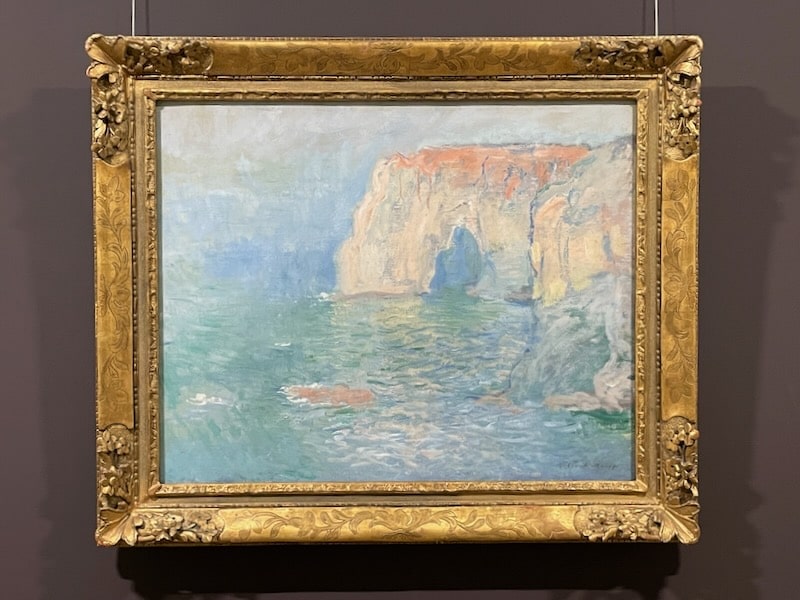 Painted during Monet’s stay on the Normandy coast, La Manneporte à Étretat (1886) captures the changing light on Étretat’s sea arch, one of his most studied coastal subjects. It now hangs in Caen’s Musée des Beaux-Arts ©OffbeatFrance
Painted during Monet’s stay on the Normandy coast, La Manneporte à Étretat (1886) captures the changing light on Étretat’s sea arch, one of his most studied coastal subjects. It now hangs in Caen’s Musée des Beaux-Arts ©OffbeatFranceThe second is a heritage museum, the Musée de Normandie, which traces the region’s history from prehistoric times to the 20th century. Some of the most interesting collections contain items from daily life and crafts that show how the people of Normandy once lived.
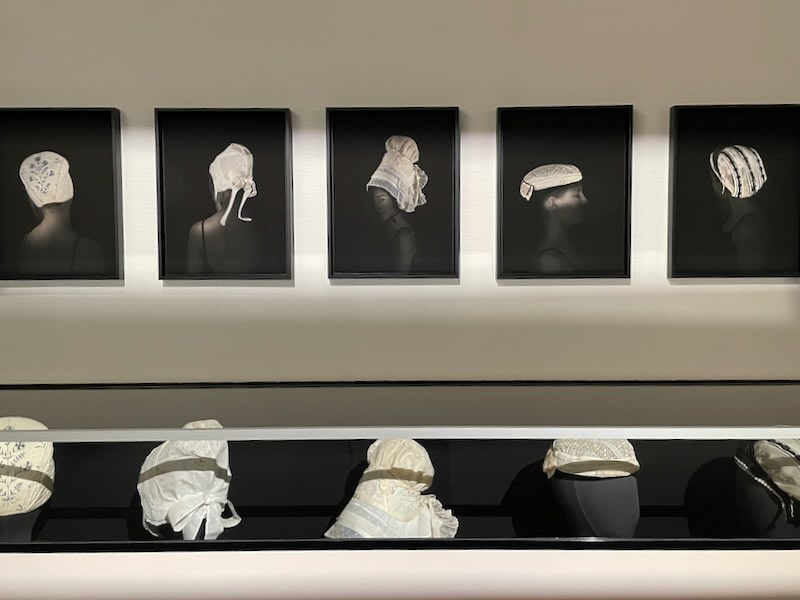 Worn across the region well into the 19th century, these traditional Norman lace and linen headpieces marked a woman’s village, age and social status ©OffbeatFrance
Worn across the region well into the 19th century, these traditional Norman lace and linen headpieces marked a woman’s village, age and social status ©OffbeatFranceAbbaye aux Hommes
The Abbaye aux Hommes, or Men's Abbey, was William the Conqueror's way of reconciling with Rome. He founded it in 1063 as penance for marrying Matilda of Flanders, his cousin, whom he married without the approval of the church.
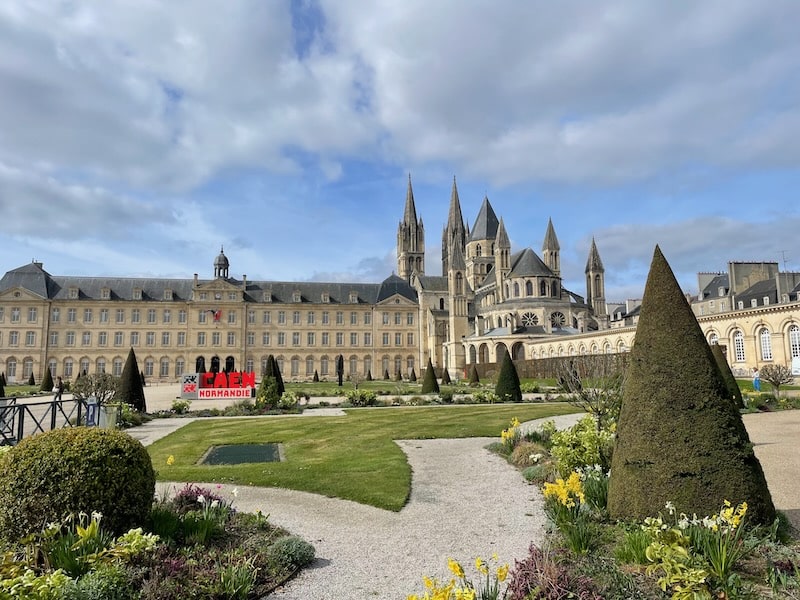 The Abbaye aux Hommes and church, next to what is now Caen's city hall ©OffbeatFrance
The Abbaye aux Hommes and church, next to what is now Caen's city hall ©OffbeatFranceThe ploy worked. As the foundations were being dug, Pope Nicholas II validated William's wedding and lifted the ban that had been hanging like a cloud over the newlyweds. Not only was the marriage accepted, but Rome's support helped legitimize William's rule. (The Abbaye aux Dames, see below, was part of the same reconciliation offer.)
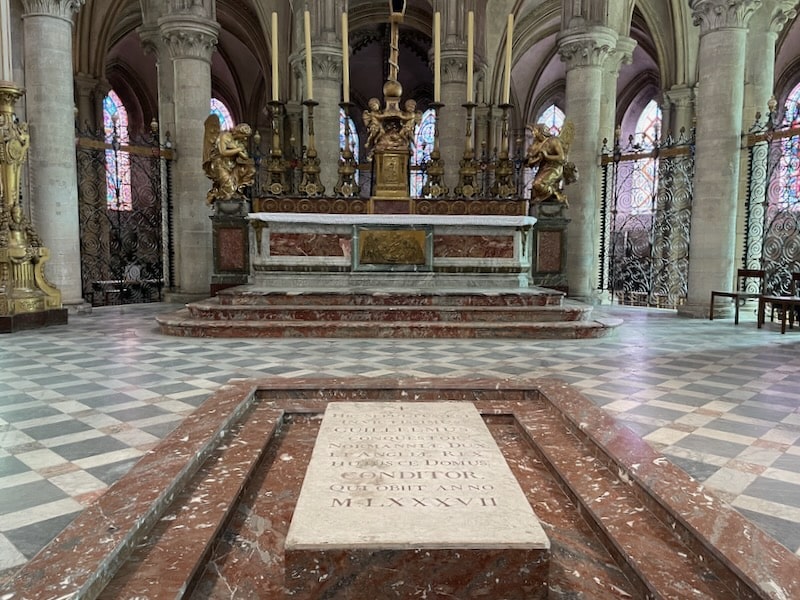
The abbey, a masterpiece of Norman Romanesque architecture, is attached to the church of Saint-Étienne, where William the Conqueror is buried (or at least his thigh bone is, the rest having disappeared after severy messy centuries, from the Wars of Religion to the French Revolution).
The tombstone isn't the original one, although the inscription still carries his name.
These days, the abbey is part of city hall, and you can tour the church and the cloisters. Better, join a walking tour in Caen and take in the compact center of the city.
Abbaye aux Dames
William's wife Matilde is buried at the other end of town, in her own abbey, the Abbaye aux Dames, founded around the same time as her husband's.
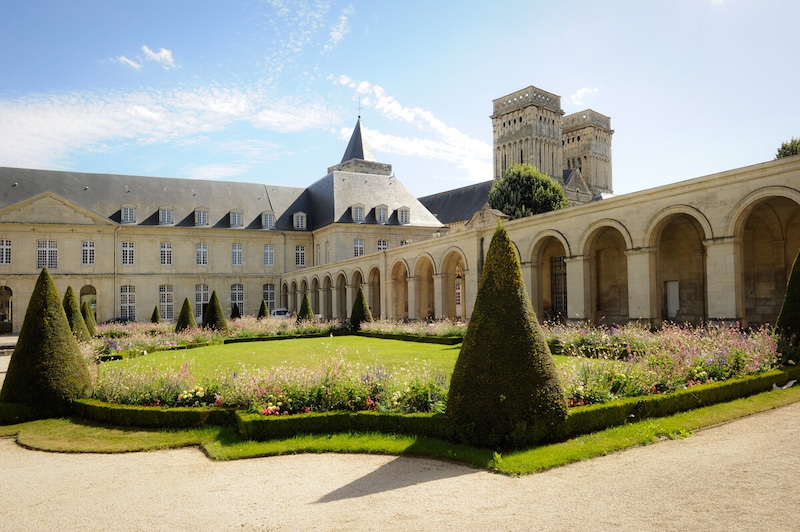 Exterior of Abbaye aux Dames. Photo Région Normandie
Exterior of Abbaye aux Dames. Photo Région Normandie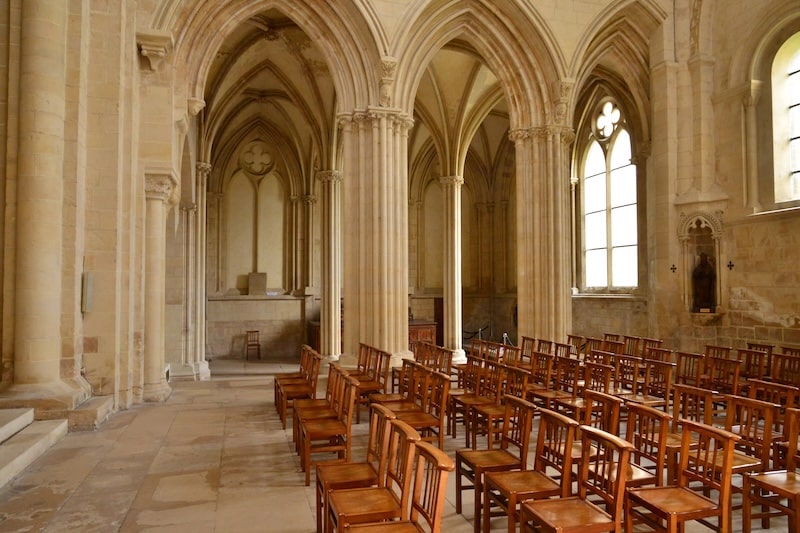 Inside the Abbaye aux Dames
Inside the Abbaye aux DamesIts church, the Sainte-Trinité, isn't as elaborate as Saint-Étienne but is striking nonetheless, with its early vaulted ceilings.
The view over Caen is quite spectacular, and it is surrounded by quiet gardens which you can visit as well.
Mémorial de Caen
Torn as I am between Caen's medieval history and its modern one, this is probably the visit I have most enjoyed on my several visits to Caen.
The memorial is a massive museum, and while most sites will suggest you dedicate two (maybe three) hours to it, I needed 4-5 – TWICE. It's that good.
The Mémorial is relatively recent, built in 1988 to commemorate the Battle of Normandy specifically but also to provide the broader story of World War II.
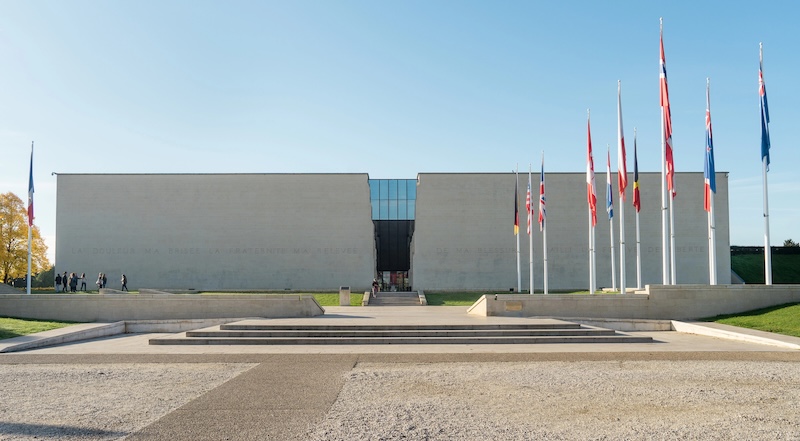 The actual building of the Caen memorial
The actual building of the Caen memorial
THE KNOTTED GUN SCULPTURE
The Knotted Gun (also known as Non-Violence) is near the entrance to Caen’s Mémorial Museum. The bronze sculpture by Swedish artist Carl Fredrik Reuterswärd was created after the 1980 murder of Beatle John Lennon in response to violence.
The original version was later placed outside the United Nations in New York, but copies like this one (over 30 to date) exist worldwide as symbols of peace and dialogue. The one in Caen reflects memories of the past and the value of peace after war.
A good place to start your visit is the documentary shown each half-hour that sets the scene.
You'll also see some temporary exhibits near the cinema entrance but beware, these are so well done that you may eat up a precious hour or two just here. I did. A recent one was about Varian Fry, the American journalist who helped people escape a holding facility at Les Milles in southern France.
After that, everything unfurls in chronological order, from the rise of totalitarianism in Europe, World War II from 1939 to 1945, the D-Day landings and Battle of Normandy, and the Cold War.
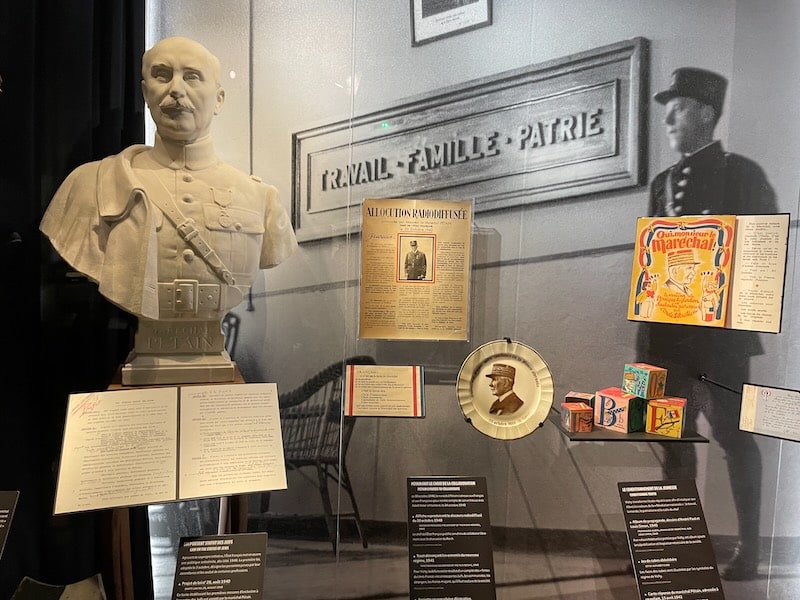
The main museum is filled with military history, of course, but it poignantly tells the story of the people affected by the war. You'll find everything from personal letters from soldiers (both Allied and German) to their loved ones to the usual militaria – weapons and uniforms. There's a section on civilian life under the Occupation, with reminders of what life was like, with such items as ration cards and illegal newspapers.
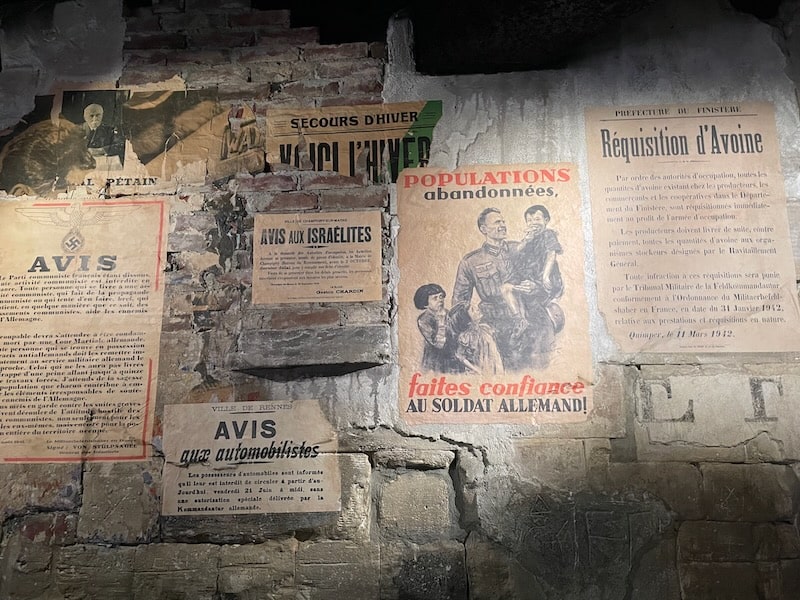
The Battle of Normandy room also has excellent maps and timelines to demonstrate how Caen fit into it all, and you'll find examples of living spaces and trenches. There's plenty more – I can't even begin to list it all, so you'll have to go see when you're next in Normandy.
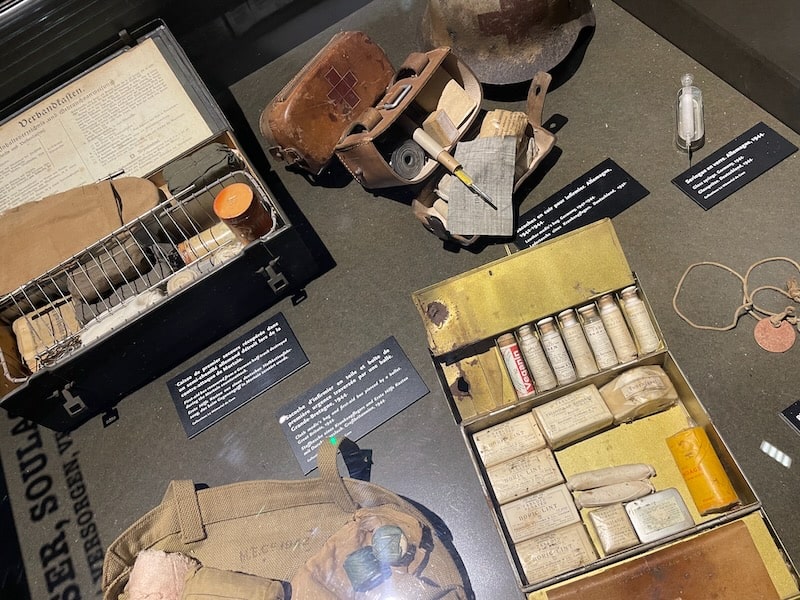 The random photos above are of a few museum exhibits to give you a flavor of the kinds of things you'll find here ©OffbeatFrance
The random photos above are of a few museum exhibits to give you a flavor of the kinds of things you'll find here ©OffbeatFranceThe Cold War section, which wasn't part of the original memorial, traces more recent history with fascinating sections on the Berlin Wall, the Cuban missile crisis and 20th-century peace movements.
It's all done in a tasteful and respectful manner and explanations are in English as well as French.
An interesting venue is at the back of the museum: a fully preserved German command bunker you can visit if you don't have mobility issues (on my most recent visit the elevator didn't work).
Near the bunker you'll also find several memorial gardens designed by veterans' associations – so peaceful, given the context.
There's a café on the premises if you're hungry, and a word of warning: it gets very crowded, especially in summer and during school holidays. Avoid some of the crowds by reserving your tickets ahead of time.
 Inside the former German bunker at the Caen Memorial ©OffbeatFrance
Inside the former German bunker at the Caen Memorial ©OffbeatFranceVaugueux Quarter
The bombings of World War II destroyed a large swathe of Caen, but fortunately, some areas escaped the bombs, at least in part.
If you're looking for medieval, half-timbered houses, head for the Vaugueux area (pronounced voh-GEUH – the G is a hard G, as in goal or guitar, and the EUH sound is the same as the E sound in her). You'll find a few here, as many were destroyed.

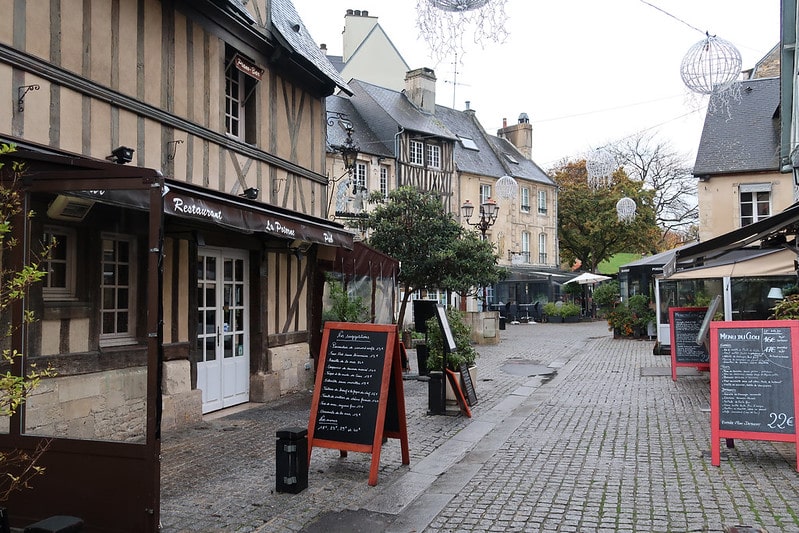 Rue du Vaugueux in Caen, one of the few remaining medieval quarters left after the severe bombing in World War II. Top photo: Caen la mer Tourisme / Les Conteurs. Bottom photo: Fred Romero (CC BY 4.0) via Flickr
Rue du Vaugueux in Caen, one of the few remaining medieval quarters left after the severe bombing in World War II. Top photo: Caen la mer Tourisme / Les Conteurs. Bottom photo: Fred Romero (CC BY 4.0) via FlickrThis is now one of Caen's most atmospheric districts and is full of restaurants and cafés. The favorite fact cited about this neighborhood is that Edith Piaf's parents lived here when she was a child, and her grandparents ran a café on these streets.
It's a lovely area to head for food at all price points. Try Sacrée Mathilde for a delicious crêpe, or Balthazar for simple French food with great service, and with a distinct advantage: when most other restaurants are closed between lunch and dinner, you can eat at the bar (and the food is good!)
Caen's churches
Much of the damage Caen suffered during the war is now invisible, the city having been rebuilt and the rubble long gone.
One exception is the church of Saint-Étienne-le-Vieux, which has been left as is to remind us that although rebuilt, Caen suffered tremendously during the war.
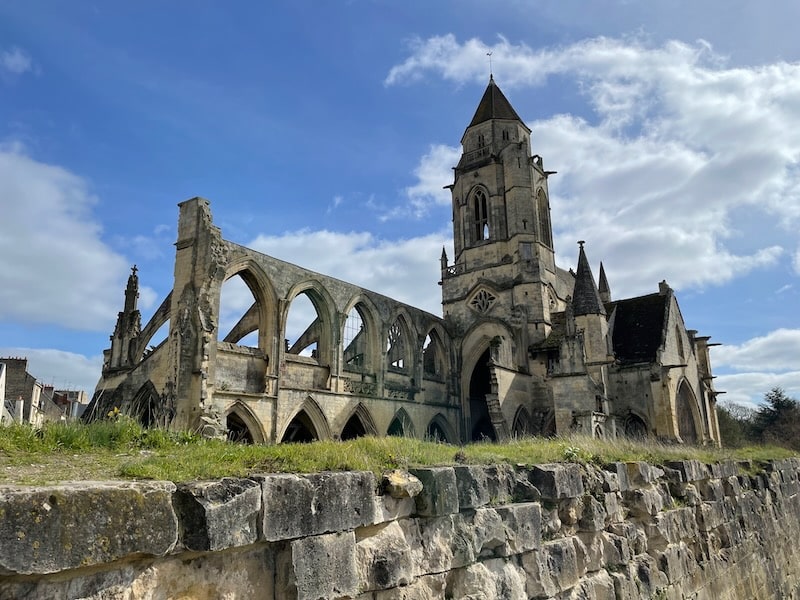 13th-century Église Saint-Étienne-le-Vieux, Caen, across from the Abbaye aux Hommes.It was badly damaged during the 1944 Battle of Caen and left unrestored as a quiet memorial to the war ©OffbeatFrance
13th-century Église Saint-Étienne-le-Vieux, Caen, across from the Abbaye aux Hommes.It was badly damaged during the 1944 Battle of Caen and left unrestored as a quiet memorial to the war ©OffbeatFranceNot everything carries the scars of bombing, and one of the most visible survivors of the war is the church of Saint-Pierre, which sits between the castle and the port. It was damaged in 1944 but carefully rebuilt – you can easily see its Gothic spire from afar, dominating the skyline.
 Church of Saint-Pierre, as seen from Caen Castle. Photo by Julien78 via Wikimedia Commons CC BY 3.0
Church of Saint-Pierre, as seen from Caen Castle. Photo by Julien78 via Wikimedia Commons CC BY 3.0Where to stay in Caen
Caen has plenty of hotels and if you've come from Paris, you'll be pleasantly surprised at their cost.
For hotels near the center of town, try the Hotel La Fontaine or the quirky Hôtel François d’O, both of which are within walking distance of most sights. The Campanile is also a good budget option.
If you'd rather be near the Memorial, Best Western Plus Le Moderne is practical and comfortable.
Around Caen
Caen is a great base if you want to explore the area – and there is plenty to see.
- The city of Bayeux, home of the famous tapestry (unfortunately the tapestry museum is being renovated until 2027)
- The D-Day beaches, some of which, like Sword, are just 20 minutes away
- The village of Ouistreham and its tiny museum of No.4 Commando, the French-British brigade who landed at Sword; a second larger museum about World War II is also very much worth visiting
- Pegasus Bridge and its museum
- The town of Falaise, William the Conqueror's birthplace and restored castle
Getting to Caen and getting around
Getting to Caen is easy. It is a 2.5-hour drive from Paris, and about the same by train. I've done both and my personal recommendation, if at all possible, is to take the train to Caen, and rent a car there if you'd like to visit the coast.
The city of Caen is renowned for its traffic, especially at rush hour, and I was stuck on a bridge high (very high!) over the water for more than an hour as a five-car pileup was cleared on a Monday morning...
The train, on the other hand, is painless and in the center of town, and you'll easily be able to navigate throughout the city on local transport.
As is the case in many French cities, taxis are rare and expensive, and Uber-type services virtually non-existent.
A quick word about the weather: this is Normandy, and it's famed for its rain. That said, the rains often pass so quickly you barely have time to open your umbrella. The clouds hover, water pours from gray skies, but suddenly you're staring at a great blue expanse filled with sunshine. Go figure.
FAQ
Is Caen worth visiting?
Is Caen worth visiting?
Oh yes, no question, especially if you love history, which it covers from the Middle Ages to World War II, from William the Conqueror’s castle to the Mémorial Museum for Peace.
How long should I spend in Caen?
How long should I spend in Caen?
One full day covers the main sights, but two days allow time for the abbeys, museums, and a trip to the D-Day beaches.
Can you visit Caen without a car?
Can you visit Caen without a car?
Yes. The city is walkable, and buses connect the Mémorial, the abbeys, and the station. Caen is known for its traffic so you're actually better off without a car.
Before you go...
Many cities are more beautiful than Caen, much of which was destroyed by war. But when it comes to history, you'll find few places that can compare, and what is left is truly stunning.
Spend a day or two and you'll be in the heart of the history of Normandy...
Header image by Julian Cosson (CC BY-NC 2.0) via Flickr
Did you enjoy this article? I'd love if you shared it!

